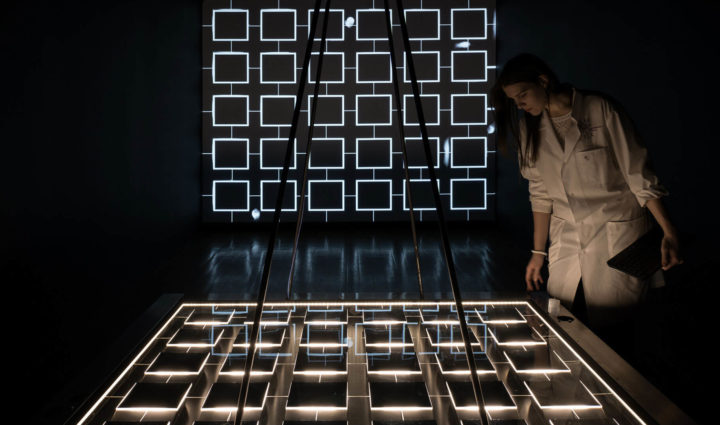Artists of “Where Dogs Run” art-group from Ekaterinburg together with scientists immerse into electro-physical experiments, test risky hypotheses, model the interaction of various types of substance.
Three projects are presented within the exhibition. They combine rational and spontaneous, absurd and clever, positivist and beautiful.

Digitization of Water
installation, 2004
Exhibition opening 
Fields, 2008
installation
Project “.” or landscape watching itself, 2008
video installation
Van de Graaff generator 
Exhibition opening 
Where Dogs Run art-group 
Where Dogs Run art-group 
Digitization of Water
installation, 2004
❶ Jelly and lightnings (2008)
Artists wondered what would happen to a cube of jelly treated by artists as the substance of uncertainty if effected by lightning. And they have made an experiment. The electric spark produced by Van de Graaff generator strikes in blue jelly substance. It may miss, but when it hits the mark, the jelly sparks and flashes brightly. The spectators witness both a scientific experiment and an art-work.

sketch
❷ Fields (2008)
Installation is created in cooperation with scientists from the Ural University Centre “Modern nanotechnologies”.
The project is build around the ferrofluid – the material traditionally used in nannothecnology experiments. Ferrofluids are colloidal mixtures composed of nanoscale ferromagnetic particles suspended in a carrier fluid, usually an organic solvent or water. Some of its properties like electroconductivity are still open for investigation and research. In course of the experiment the ferrofluid becomes strongly polarised in the presence of a magnetic field and due to the instability caused by a magnet beneath the dish it amazingly re-shapes. Rotation of constant magnets creates the difficult, moving field influencing the ferrofluid. Its pattern is never repeated. This transmutation might be considered a purely technological process if only the artists would not wish to control it visually. They placed two micro cameras instead of the gauges fixing changes of ferrofluid parameters and broadcast the image on the screens.

❸ Digitization of water (2004)
The installation consists of the pyramid build of the vessels arranged as the system of “self-description” and “self-discipline” of water. Moving down from a vessel on the top of the pyramid to vessels of the bottom level by random ways. The system of magnetic switches registers the water course, and this data is transformed into a stream of bits. The received data are displayed on the computer monitor, printed out, and by this turn into digitally generated music. Digital language of the description of water is bred by human aspiration to wonderful which meets the water’s intention to be calculated.






